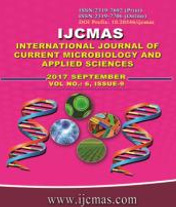


 National Academy of Agricultural Sciences (NAAS)
National Academy of Agricultural Sciences (NAAS)

|
PRINT ISSN : 2319-7692
Online ISSN : 2319-7706 Issues : 12 per year Publisher : Excellent Publishers Email : editorijcmas@gmail.com / submit@ijcmas.com Editor-in-chief: Dr.M.Prakash Index Copernicus ICV 2018: 95.39 NAAS RATING 2020: 5.38 |
Seven algal species were collected from 7 different hotspots along Alexandrian Mediterranean shore; toluene and ethanol extract of U. fasciata and Enteromopha intestinalis showed the maximum antibacterial although Klebsiella pneumoniae (2) showed highest sensitivity towards the algal extracts while MRSA and MRSE were the most resistant organisms. MIC concentration was significantly low with Gram negative bacteria less than Gram positive bacteria. Time –Kill curve analysis showed that MRSA was less susceptible than Ps. aeruginosa with the same extract. SEM analysis of the samples showed aggregation and shrinkage in addition to leakage of the cells. LC50 was determined during the period of one week and no mortality was observed. Combination between algal extract and amikacin showed significant increase in the inhibition zone. Synergistic action was noticed between the silver nanoparticles (green synthesized by the U. fasciata extract) + amikacin (as known antibiotic) and U. fasciata extract (as the natural product). This synergy means less toxicity, less side effects and less cost. GC-MS-MS analysis of the U. fasciata sample showed Acyclic and noracyclic sesterterpenoid, pentacyclic triterpenoid, esters and carotenoid. Column chromatography was performed followed by antibacterial assay for the collected fractions to determine the active fraction. The isolated active compound was olean-12en-3, 15, 16, 21, 22, 28-hexol, with probability only 91.17% so probably our isolated compound is a derivative of oleanolic acid.
 |
 |
 |
 |
 |